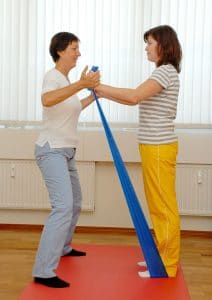Vertebral Body Fracture: Therapy for Vertebral Fracture in Munich
A vertebral body fracture (vertebral body break) occurs either from an outside force or because the patient’s osseous structure is already damaged – owing to osteoporosis for example. The break can affect different points or sections of the vertebrae, but it usually occurs in the lumbar spine or thoracic spine. In most cases, patients suffer for months or even years with chronic back pain as a result of a fracture – this responds very well to treatment!
What causes a vertebral body fracture?
A vertebral body break can occur either through an accident or the depletion of osseous substance in the patient’s spine (as a result of osteoporosis, for example) leading to an increased risk of breaks:
- Through trauma: The fracture happens during an accident (falling down stairs, sport or a car accident with a collision and compression of the spine)
- Disease: The fracture is usually a consequence of osteoporosis which makes the bones affected porous. Alongside these so-called osteoporotic vertebral body fractures, rheumatic diseases or bone metastases if there is a tumour (cancer) also leads to a weakening of the bone structure.
Vertebral fracture mostly affects older people who suffer from osteoporosis. The bones become ever more porous and unstable, owing to progressive depletion over time. The vertebrae can break even without significant force being applied – often normal load-bearing in everyday life is sufficient. This so-called vertebral compression factor primarily affects the lower thoracic vertebrae and the upper lumbar vertebra. If the vertebrae fracture has occurred in the cervical spine, it usually affects the lower cervical vertebrae. If several of these fractures occur simultaneously, the torso shortens and a stooped back develops (so-called dowager’s hump or widow’s hump).

Magnetic resonance imaging of a vertebral body fracture
What are the symptoms of a vertebral body fracture?

Medical graphics: (Osteoporotic) vertebral body fracture
A fractured vertebra is normally very painful for the patient. If the break is not treated, chronic back pain can develop. The pain often radiates outwards and is difficult for sufferers to localise. Further symptoms of the fracture are limited mobility of the spine which leads to a considerable loss of quality of life. But also signs of a spinal cord injury such as paralyses, a feeling of numbness in the area of the arms and legs or functional disorders when emptying the bladder or bowel can indicate a vertebral fracture.
How is a vertebral body fracture treated?
Treatment for a vertebral body fracture
Stable break
Conservative before bone healing:
- Bed rest
- Pain-relieving medication
- Orthosis (support corset)
Conservative after bone-healing:
- Physiotherapy
- Targeted back health exercises
Unstable break
Minimally-invasive therapy:
- Vertebroplasty
- Kyphoplasty
Surgical:
- Spondylodesis
As far as it is possible and sensible, we rely on conservative therapy, on the one hand, to relieve you, the patient, of pain and on the other, to avoid an operation. We recommend a tailored treatment concept for you based upon a thorough clinical examination, analysis and diagnosis that we carry out on the same day at our premises, including imaging procedures. The treatment possibilities also depend on whether it is a stable or unstable fracture:
Unstable vertebral body fracture

Treatment example: Physiotherapy for patients
Minimally-invasive therapies are used if there is a danger of spinal cord injury as a result of an unstable vertebral body fracture. We speak of an unstable fracture if either the central column or the dorsal column of the vertebral body is affected. The central column includes the so-called vertebral joint rear edge, i.e. the rear surface of a vertebral body; the dorsal column includes, in particular, the vertebral joints. Even if the pain is very severe or there has been a considerable height loss in the vertebra affected, a minimally-invasive intervention on the spine can be helpful.
Minimally-invasive intervention on the spine
In our four specialised medical care centres, we frequently turn to vertebroplasty or kyphoplasty to treat an unstable vertebral body fracture, depending on the diagnosis: Thanks to these new, minimally-invasive procedures, open surgery and painful scarring can be avoided. Access through the skin takes place via a thin puncture needle – this is gentle on the muscles and supporting tissue around the spine:
During vertebroplasty, we pass the puncture needle into the vertebral body and inject harmless liquid osseous cement into the bones. After the cement has hardened, the vertebral body is permanently stabilised again. If the vertebral body is severely deformed, we carry out balloon kyphoplasty. This procedure is similar to vertebroplasty, but the vertebral body is first straightened out with the help of a balloon before the cement is injected.

Medical graphics: Microsurgical injection of bone cement
If nothing else helps: Operation
If the vertebral body fracture occurred as a consequence of an accident and there is pronounced deformation of the vertebral body including the rear edge of the vertebral body, spondylodesis can help. The broken vertebra is splinted to the bordering vertebrae using a system of screws and rods.
This thereby prevents a vertebral body fracture from occurring
You can reduce the risk of fracture occurring. If an underlying disease such as osteoporosis exists, correct early treatment can prevent a vertebral body fracture occurring later. However, if you take care during sporting and everyday activity, you have already done a great deal towards prevention.


We are here for you!
jameda review from 12/2018
Wiltrud Rakel, OP spinal canal stenosis, 2018.
"A competent and very confident statement at diagnosis, "golden hands" at surgery WS canal stenosis. Thank you Dr. Hadi for a new pain free life.
Your Wiltrud Rakel"






